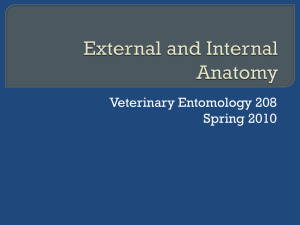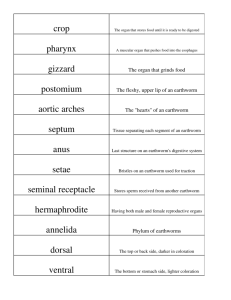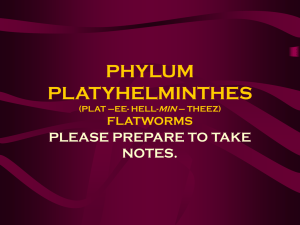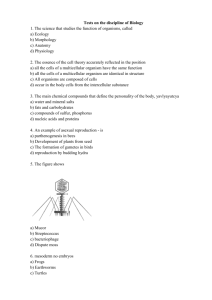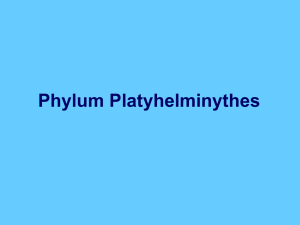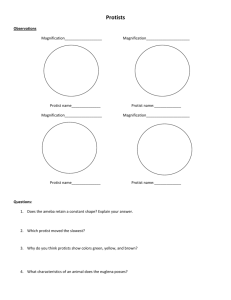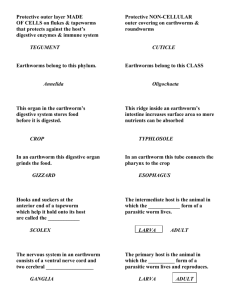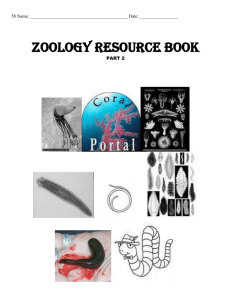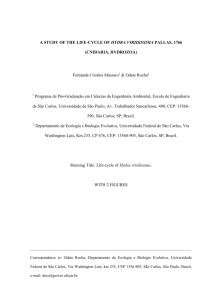Review questions for Exam #3
advertisement
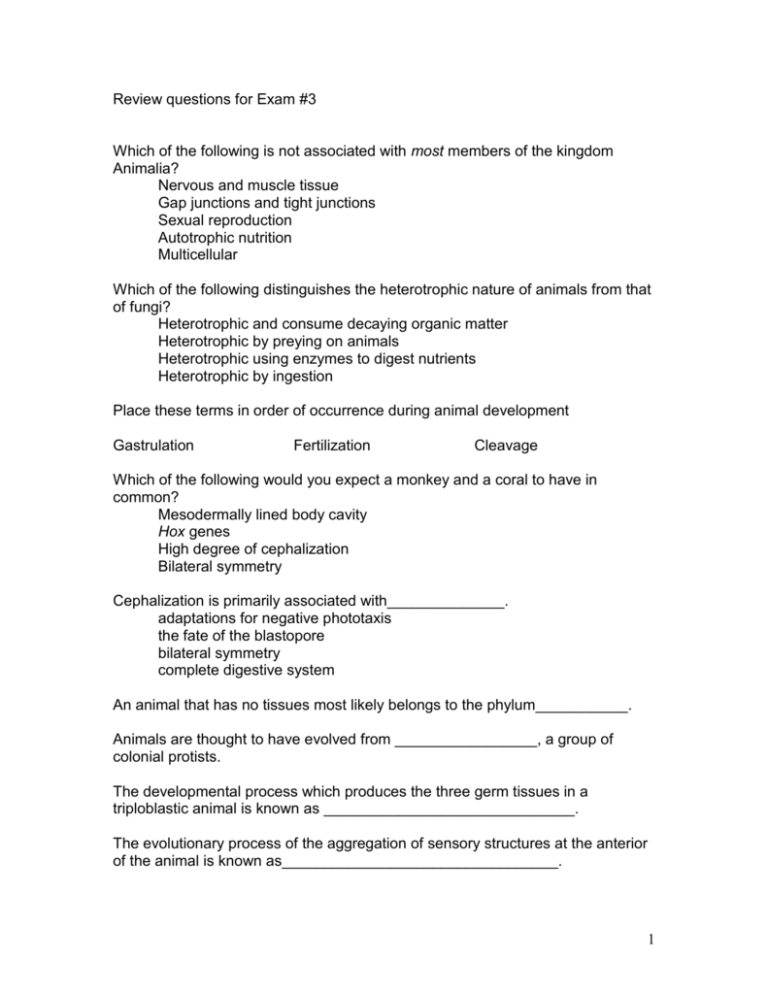
Review questions for Exam #3 Which of the following is not associated with most members of the kingdom Animalia? Nervous and muscle tissue Gap junctions and tight junctions Sexual reproduction Autotrophic nutrition Multicellular Which of the following distinguishes the heterotrophic nature of animals from that of fungi? Heterotrophic and consume decaying organic matter Heterotrophic by preying on animals Heterotrophic using enzymes to digest nutrients Heterotrophic by ingestion Place these terms in order of occurrence during animal development Gastrulation Fertilization Cleavage Which of the following would you expect a monkey and a coral to have in common? Mesodermally lined body cavity Hox genes High degree of cephalization Bilateral symmetry Cephalization is primarily associated with______________. adaptations for negative phototaxis the fate of the blastopore bilateral symmetry complete digestive system An animal that has no tissues most likely belongs to the phylum___________. Animals are thought to have evolved from _________________, a group of colonial protists. The developmental process which produces the three germ tissues in a triploblastic animal is known as ______________________________. The evolutionary process of the aggregation of sensory structures at the anterior of the animal is known as_________________________________. 1 Can a parazoan be diploblastic? Yes or no Can a eumetazoan be triploblastic? Yes or no What does sessile mean? Can a coelomate animal be a protostome? Yes or no Can a pseudocoelomate animal be a deuterostome? Yes or no Which of the following describes feed by a typical sponge? Active fast moving predator Feeds on decomposing material Feeds on nutrients and plankton suspended in the water column Feeds by using symbiotic autotrophic algae What is spongin? What feature can distinguish a coelomate animal from a pseudocoelomate? A body cavity Bilateral symmetry A body cavity which is completely lined with mesodermally derived tissue Hydrostatic skeletons You examine an animal and find a solid mass of tissue forming the body (except for the digestive tube). You also find it curious that you can only locate one opening to the digestive system. This organism is most likely a ___________. Acoelomate pseudocoelomate coelomate An animal which swims rapidly in pursuit of prey it locates with keen vision is likely to be all of the following except: Bilaterally symmetrical Coelomate Eumetazoan Diploblastic The blastopore is associated with______________. Zygote sperm gastrula mesoderm The most ancestral branch in the phylogeny of animals is: Radial - bilateral symmetry No cephalization – cephalization Protostome – deuterostome True tissues – no tissues 2 Which of the following describes the nervous system of a jellyfish? Brain – spinal cord – lateral nerves Central ganglia – lateral and longitudinal nerves Nerve net Which of the following is characteristic of corals and planarians? Flame cells Incomplete digestive system Diploblastic Spicules The ____________ binds the ectoderm to the endoderm in a hydra. Hydra exhibit the ___________ growth form. In Obelia, the __________ growth form is sexual, while the sessile __________ growth form is asexual. The ____________ are specialized cells in a cnidarian used to capture prey. These cells function by the release of the ____________________, which penetrates the body of the prey and delivers the venom. Coral reef ecosystems rely on the actions of tiny cnidarians as they construct the mineralized coral. The primary mineral in this coral is ___________________. A Jelly fish would most likely eliminate metabolic waste using_________. Diffusion or transport across cell membranes into the water Kidneys Flame cells Gonads Name a non-parasitic flat worm we discussed in lecture___________________. Name the obligate flatworm parasites which lack a digestive system_________________. List the function for each of the following planarian body parts: Auricles – Eye spots – Flame cells – Pharynx – Gastrovascular cavity – Man can serve as the ___________ host of the beef tapeworm; beef cattle can serve as the ____________________ host. Name the intermediate host of the blood fluke (Schistosoma) . 3 What is the function of the cuticle in a nematode? What would be the most effective method of reducing the effects of schistosomiasis? Ensuring that all vegetables were properly washed before consumption Properly cooking escargot before consumption Purify drinking water with iodine Use of molluscicides to reduce aquatic snail populations Name the structures or method used for attachment in host by the following parasites: Tapeworm Fluke Human intestinal roundworm All nematodes are deadly parasites? Yes or no What is a cercaria? Fill in the missing information on the chart of parasites below Common name Scientific name Location within final host Intermediate host or vector Guinea worm Disease; description Skin irritation; secondary infection; improper removal causes severe inflammation Ascaris lumbricoides Mucosa of small intestine None; larvae spend time in soil Anemia, creeping eruption; canines serve as potential reservoir Trichinosis Human pinworm Wucheria bancrofti Canine heartworms; severe cardiac disruption 4 List the three main parts of the body of a generalized mollusk: Describe an open circulatory system. Which of the following is a bivalve? Ant oyster octopus snail fluke hydra List the phylum for each animal below: Fire ant________________________________ Squid__________________________________ American hookworm_________________________ Hydra______________________________________ Sea cucumber________________________________ Leech_______________________________________ Glass sponge____________________________________ Tapeworm_______________________________________ List the function for each of the following related to mollusks Mantle Foot Shell Radula Gills Gonads Which of the following represents the most advanced group of mollusks? Bivalves gastropods cephalopods chitons 5 To what (in gastropods) does torsion refer to? Name the structures responsible for closing the shell in a scallop. Name the structures in a mussel that are responsible for the movement of water in and out of the shell and across the body. The labial palps are located close to the _________________ (mouth/anus). Which of the following organisms exhibits metamerism? Snail Hydra earthworm fire ant crab fluke What does ecdysis refer to? In which of the following organisms would you expect to find metanephridia? Snail Hydra earthworm fire ant crab fluke List the three tagma found in a grasshopper and arrange them from anterior to posterior. Match the structure on the left with the organism on the right Flame cells Sandworm (Nereis) Parapodium Chiton Mantle Grasshopper Tracheal tubes Sea star Water vascular system Planaria The grinding portion of the digestive system of an earthworm is known as the _________________________. The reproductive segments of an earthworm form the ___________________. Name an animal which produces an anticoagulant called hirudin :______________ 6 Label each as an endoparasites or ectoparasite: Tapeworm ` Leech Deer tick Blood fluke Name the animal phylum with the greatest species diversity._____________ The extinct _____________________ are thought to be the first arthropods. Spiders have _______ (#) walking legs and ____________ chelicerae and___________ pedipalps. Which of the following animals would have biramous appendages? Black widow jelly fish crayfish squid Which of the following animals exhibits larvae with different symmetry as compared to the adult? Grasshopper horseshoe crab sand dollar Which of the following animals has an endoskeleton? Grasshopper horseshoe crab sand dollar As related to an earthworm, what are seta? Name the tagma each on which appendage originates as seen in a crayfish. Antennae Uropod Cheliped Mandibles Swimmerets Maxillipeds Name the group of arthropods which have wings. Type of symmetry seen in an adult echinoderm 7 Complete the following: Protostome Deuterostome Type of cleavage Formation of coelom Fate of blastopore Included phyla Describe the type of metamorphosis seen in insects. Match each organism on the left with the group it belongs to on the right Crayfish Scorpion crustaceans Tarantula arachnids June beetle myriapods Mosquito hexapods Millipede Barnacle Centipede Which group listed below has no terrestrial forms? Mollusks echinoderms arthropods annelids 8

